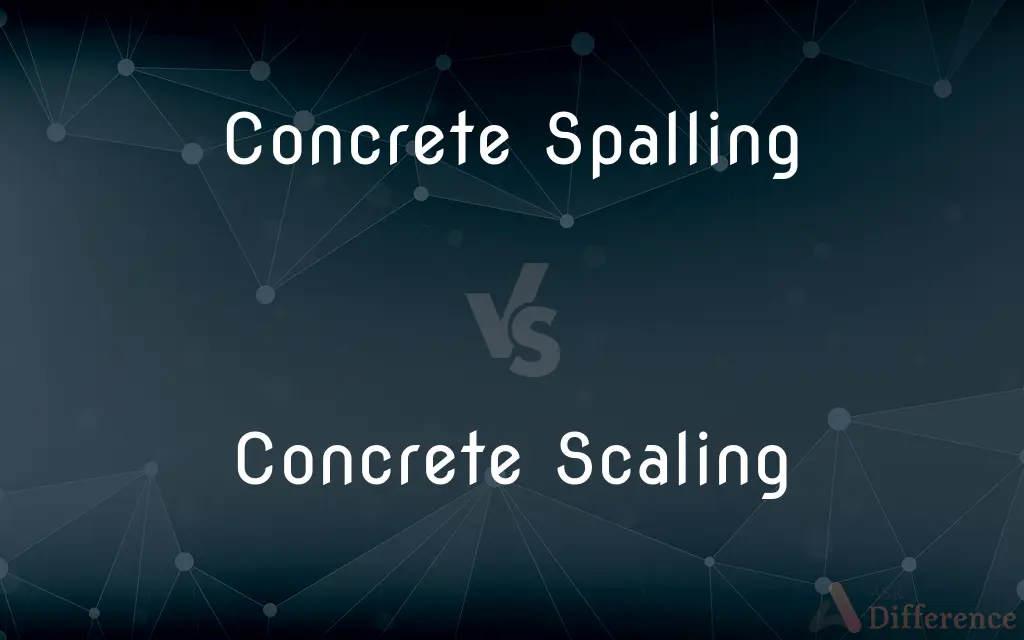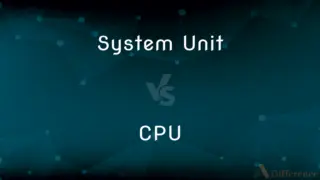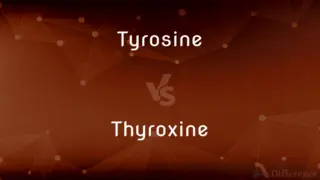Concrete Spalling vs. Concrete Scaling — What's the Difference?
By Maham Liaqat & Urooj Arif — Published on June 22, 2024
Concrete spalling involves the breaking off of surface layers, revealing structural damage, while scaling refers to surface flaking due to freeze-thaw cycles and poor finishing.

Difference Between Concrete Spalling and Concrete Scaling
Table of Contents
ADVERTISEMENT
Key Differences
Concrete spalling is characterized by the chipping or breaking off of pieces of concrete, often exposing the reinforcing steel within and indicating deeper structural issues. On the other hand, concrete scaling involves the surface layer of concrete peeling away in thin layers, typically as a result of environmental factors like freeze-thaw cycles, and does not usually affect the structural integrity as severely.
Spalling is often caused by rebar corrosion, freeze-thaw cycles, or chemical attacks, leading to significant structural damage that requires immediate attention. Scaling, while also potentially caused by freeze-thaw cycles, is more frequently linked to inadequate concrete finishing, improper curing, or the use of deicing chemicals, resulting in a rough and pitted surface appearance.
The repair processes for spalling and scaling differ significantly due to the extent of damage. Spalling repair might involve removing loose concrete, treating or replacing corroded rebar, and filling with a repair mortar. Scaling repairs are generally less intensive, often requiring only the removal of loose material and resurfacing of the affected area.
Preventative measures for both conditions include using high-quality concrete, proper curing, and applying sealants to protect the surface. However, in the case of spalling, additional steps like ensuring proper concrete coverage of rebar and using corrosion inhibitors can be crucial.
Both spalling and scaling can detract from the appearance and functionality of concrete structures, but spalling is generally more critical due to its potential impact on structural integrity. Scaling, while primarily aesthetic, can lead to more significant damage if left untreated.
ADVERTISEMENT
Comparison Chart
Definition
Chipping or breaking off of concrete, exposing rebar and indicating deeper damage.
Surface flaking or peeling, often due to environmental factors.
Causes
Rebar corrosion, freeze-thaw cycles, chemical attacks.
Freeze-thaw cycles, inadequate finishing, deicing chemicals.
Impact
Can affect structural integrity, requiring immediate repair.
Primarily aesthetic, but can lead to further damage if untreated.
Repair Process
Involves removing damaged concrete, treating rebar, and filling with repair mortar.
Generally involves removing loose material and resurfacing.
Prevention
Use of quality concrete, proper coverage of rebar, use of corrosion inhibitors.
Proper curing, finishing, and application of sealants.
Compare with Definitions
Concrete Spalling
The deterioration of concrete resulting in chunks breaking off, often revealing internal steel reinforcement.
The bridge showed signs of concrete spalling, with large pieces of the surface crumbling away.
Concrete Scaling
A surface defect characterized by the flaking away of the concrete surface, often due to environmental exposure.
After the harsh winter, the driveway exhibited noticeable concrete scaling, detracting from its appearance.
Concrete Spalling
Include proper construction practices, adequate concrete cover over rebar, and the use of corrosion inhibitors.
To prevent future concrete spalling, the contractor ensured a sufficient concrete cover over the rebar and applied a protective sealant.
Concrete Scaling
Proper curing and protection of the concrete surface, especially in climates prone to freeze-thaw cycles.
The contractor recommended applying a high-quality sealant to protect the concrete from scaling in the future.
Concrete Spalling
Leads to significant structural issues, compromising the integrity and safety of the structure.
The spalling on the building's facade not only looked unsightly but also raised concerns about the building's overall stability.
Concrete Scaling
Often results from freeze-thaw cycles, improper concrete mix, or finishing techniques.
The concrete scaling was likely due to the use of deicing chemicals and the area's frequent freeze-thaw cycles.
Concrete Spalling
Typically caused by environmental factors, poor construction, or rebar corrosion.
The concrete spalling was attributed to the corrosion of the embedded steel reinforcement due to moisture infiltration.
Concrete Scaling
Primarily affects the aesthetic appeal and surface smoothness, with less impact on structural integrity.
While the concrete scaling was unsightly, it did not pose an immediate threat to the structure's safety.
Concrete Spalling
Repair often involves extensive work, including removing damaged concrete, treating or replacing corroded rebar, and applying repair mortar.
The repair team used a comprehensive approach to address the concrete spalling, ensuring the longevity of the structure.
Concrete Scaling
Repair can usually be done by removing loose concrete and applying a new surface layer or sealant.
To address the scaling, the damaged surface layer was removed, and a new top layer was applied to restore the driveway's appearance.
Common Curiosities
Is concrete scaling a serious issue?
While concrete scaling is primarily a cosmetic issue, it can lead to further deterioration if not addressed.
What is concrete spalling?
Concrete spalling refers to the breaking or chipping off of concrete pieces, often exposing the internal reinforcement and indicating deeper structural problems.
What causes concrete scaling?
Concrete scaling is typically caused by freeze-thaw cycles, improper concrete mixture or finishing, and the use of deicing chemicals.
How does improper curing contribute to concrete issues?
Improper curing can lead to inadequate hydration of the concrete, making it more susceptible to environmental damage and scaling.
What is the difference between spalling and scaling in terms of visibility?
Spalling is usually more visually apparent due to larger chunks breaking off, while scaling involves more subtle surface flaking.
How can you prevent concrete spalling?
Preventing concrete spalling involves using high-quality concrete, ensuring proper rebar coverage, and applying corrosion inhibitors.
Can both spalling and scaling be repaired?
Yes, both spalling and scaling can be repaired, though spalling requires more extensive intervention due to its impact on structural integrity.
Can deicing salts cause both spalling and scaling?
Yes, deicing salts can contribute to both conditions by increasing the number of freeze-thaw cycles and penetrating the concrete surface.
Does scaling affect the strength of concrete?
Scaling primarily affects the surface and is less likely to compromise the concrete's structural strength, unlike spalling.
Are there specific environments where spalling is more common?
Spalling is more common in environments with high moisture, freeze-thaw cycles, and exposure to chemicals.
How does rebar corrosion lead to concrete spalling?
Corrosion of the rebar creates expansion forces within the concrete, leading to cracking and eventual spalling.
What is the best time to address spalling and scaling issues?
It's best to address these issues as soon as they're detected to prevent further damage and ensure structural safety.
Can both spalling and scaling occur on the same structure?
Yes, a structure can experience both conditions, often due to overlapping causes such as moisture and freeze-thaw cycles.
Are there any specific coatings to prevent scaling?
Sealants and coatings designed for exterior concrete can provide a protective barrier against moisture and reduce the risk of scaling.
Is it more cost-effective to prevent or repair spalling and scaling?
Prevention is generally more cost-effective, as repairs, especially for spalling, can be extensive and costly.
Share Your Discovery

Previous Comparison
System Unit vs. CPU
Next Comparison
Tyrosine vs. ThyroxineAuthor Spotlight
Written by
Maham LiaqatCo-written by
Urooj ArifUrooj is a skilled content writer at Ask Difference, known for her exceptional ability to simplify complex topics into engaging and informative content. With a passion for research and a flair for clear, concise writing, she consistently delivers articles that resonate with our diverse audience.













































